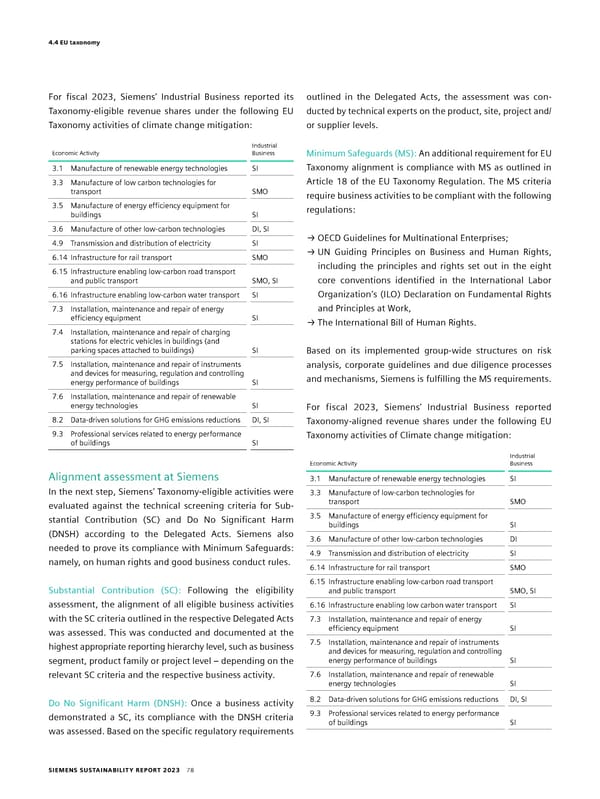4.4 EU taxonomy For fiscal 2023, Siemens’ Industrial Business reported its outlined in the Delegated Acts, the assessment was con- Taxonomy-eligible revenue shares under the following EU ducted by technical experts on the product, site, project and/ Taxonomy activities of climate change mitigation: or supplier levels. Industrial Economic Activity Business Minimum Safeguards (MS): An additional requirement for EU 3.1 Manufacture of renewable energy technologies SI Taxonomy alignment is compliance with MS as outlined in 3.3 Manufacture of low carbon technologies for Article 18 of the EU Taxonomy Regulation. The MS criteria transport SMO require business activities to be compliant with the following 3.5 Manufacture of energy efficiency equipment for regulations: buildings SI 3.6 Manufacture of other low-carbon technologies DI, SI → OECD Guidelines for Multinational Enterprises; 4.9 Transmission and distribution of electricity SI → UN Guiding Principles on Business and Human Rights, 6.14 Infrastructure for rail transport SMO including the principles and rights set out in the eight 6.15 Infrastructure enabling low-carbon road transport and public transport SMO, SI core conventions identified in the International Labor 6.16 Infrastructure enabling low-carbon water transport SI Organization’s (ILO) Declaration on Fundamental Rights 7.3 Installation, maintenance and repair of energy and Principles at Work, efficiency equipment SI → The International Bill of Human Rights. 7.4 Installation, maintenance and repair of charging stations for electric vehicles in buildings (and parking spaces attached to buildings) SI Based on its implemented group-wide structures on risk 7.5 Installation, maintenance and repair of instruments analysis, corporate guidelines and due diligence processes and devices for measuring, regulation and controlling and mechanisms, Siemens is fulfilling the MS requirements. energy performance of buildings SI 7.6 Installation, maintenance and repair of renewable energy technologies SI For fiscal 2023, Siemens’ Industrial Business reported 8.2 Data-driven solutions for GHG emissions reductions DI, SI Taxonomy- aligned revenue shares under the following EU 9.3 Professional services related to energy performance Taxonomy activities of Climate change mitigation: of buildings SI Industrial Economic Activity Business Alignment assessment at Siemens 3.1 Manufacture of renewable energy technologies SI In the next step, Siemens’ Taxonomy-eligible activities were 3.3 Manufacture of low-carbon technologies for evaluated against the technical screening criteria for Sub- transport SMO stantial Contribution (SC) and Do No Significant Harm 3.5 Manufacture of energy efficiency equipment for buildings SI (DNSH) according to the Delegated Acts. Siemens also 3.6 Manufacture of other low-carbon technologies DI needed to prove its compliance with Minimum Safeguards: 4.9 Transmission and distribution of electricity SI namely, on human rights and good business conduct rules. 6.14 Infrastructure for rail transport SMO 6.15 Infrastructure enabling low-carbon road transport Substantial Contribution (SC): Following the eligibility and public transport SMO, SI assessment, the alignment of all eligible business activities 6.16 Infrastructure enabling low carbon water transport SI with the SC criteria outlined in the respective Delegated Acts 7.3 Installation, maintenance and repair of energy was assessed. This was conducted and documented at the efficiency equipment SI highest appropriate reporting hierarchy level, such as business 7.5 Installation, maintenance and repair of instruments and devices for measuring, regulation and controlling segment, product family or project level – depending on the energy performance of buildings SI relevant SC criteria and the respective business activity. 7.6 Installation, maintenance and repair of renewable energy technologies SI Do No Significant Harm (DNSH): Once a business activity 8.2 Data-driven solutions for GHG emissions reductions DI, SI demonstrated a SC, its compliance with the DNSH criteria 9.3 Professional services related to energy performance was assessed. Based on the specific regulatory requirements of buildings SI SIEMENS SUSTAINABILITY REPORT 2023 78
 Sustainability Report Page 77 Page 79
Sustainability Report Page 77 Page 79